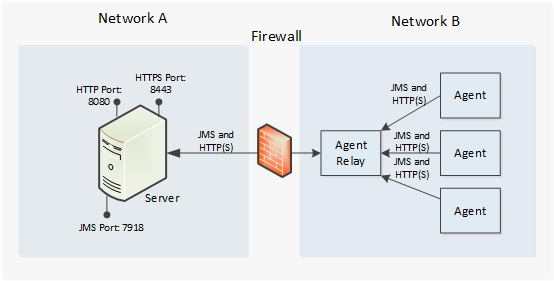As long as there is at least a low bandwidth WAN connection between the server and remote agents, the server can send work to agents located in other geographic locations. To aid performance and ease maintenance, Deployment Automation uses agent relays to communicate with remote agents. When you configure agents to connect though an agent relay, this requires only a single machine in the remote network, the agent relay, to contact the server. This enables all agent-server communication from the remote network to go through the agent relay to the server.
The following, a simple artifact move, illustrates the mechanics of remote communications:
-
A remote agent starts and establishes a connection to the agent relay through JMS, and the agent relay then alerts the server through JMS that the remote agent is online.
-
The server sends an artifact download command to the agent relay through JMS, and the agent relay delivers the message to the remote agent, also through JMS.
-
The server locates the artifacts, and then:
-
Uploads the artifacts over HTTP(S) to the agent relay, which begins streaming them directly to the agent over the server-to-agent relay HTTP(S) connection.
-
Once the remote agent completes the work, it informs the server through JMS.
-
Agent Relays in a Cross-Network Configuration

Remote agents open connections to the agent relay. By default, agent relays open the connection to the server, but the direction can be reversed to be server-initiated if your firewall requires it. See Server-initiated HTTP Communication Using Agent Relays.